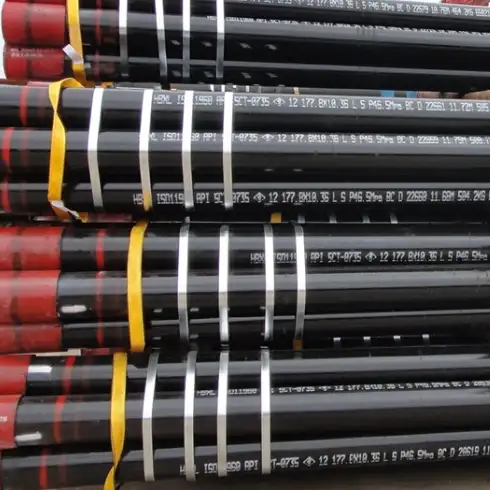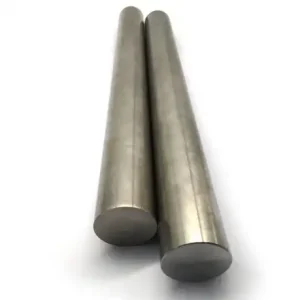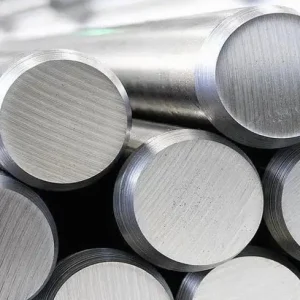API Spec 5DP drill pipe manufactured to PSL requirements provides reliable, high-strength tubing for drilling operations worldwide; when produced and inspected to specification it offers predictable tensile and fatigue performance, simple field inspection criteria, and long service life for standard, heavyweight, and specialty drill strings.
What is API 5DP Drill Pipe?
API 5DP drill pipe constitutes a specialized steel tubular component designed specifically for rotary drilling applications in oil and gas exploration. The American Petroleum Institute developed this standard to establish uniform requirements for manufacturing, testing, and quality control of drill pipe used in petroleum and natural gas industries.
The fundamental design incorporates seamless steel tubes with upset ends, featuring tool joints that facilitate connection between individual sections. These components must withstand tremendous mechanical stresses, including tensile loads from pipe weight, torsional forces during rotation, and internal pressure from drilling fluids.
We manufacture API 5DP drill pipe using high-strength steel alloys that meet stringent mechanical property requirements. The pipe body features precise dimensional tolerances, while tool joints undergo specialized heat treatment processes to achieve optimal hardness levels. This combination ensures reliable performance in demanding downhole environments.
What is the Chemical Composition of API 5DP Drill Pipe?
The chemical composition of API 5DP drill pipe varies according to specific grade requirements, with careful control of alloying elements to achieve desired mechanical properties.
| Element | Grade E | Grade X-95 | Grade G-105 | Grade S-135 |
|---|---|---|---|---|
| Carbon (C) | 0.28-0.35% | 0.32-0.39% | 0.29-0.36% | 0.24-0.30% |
| Manganese (Mn) | 0.85-1.50% | 1.20-1.65% | 1.15-1.65% | 0.85-1.50% |
| Silicon (Si) | 0.20-0.50% | 0.20-0.45% | 0.20-0.45% | 0.20-0.35% |
| Phosphorus (P) | ≤0.030% | ≤0.025% | ≤0.025% | ≤0.025% |
| Sulfur (S) | ≤0.030% | ≤0.015% | ≤0.015% | ≤0.015% |
| Chromium (Cr) | 0.40-1.00% | 0.65-1.10% | 0.70-1.20% | 0.40-0.70% |
| Nickel (Ni) | ≤0.25% | 0.40-0.70% | 0.40-0.80% | 0.85-1.25% |
| Molybdenum (Mo) | 0.15-0.30% | 0.25-0.45% | 0.25-0.50% | 0.35-0.65% |
Carbon content directly influences hardenability and strength characteristics, while manganese enhances toughness and workability. Chromium provides corrosion resistance and improves hardenability, particularly important in sour gas environments. Molybdenum additions increase high-temperature strength and prevent temper embrittlement.
Sulfur and phosphorus levels require strict control as these elements can cause brittleness and reduce impact toughness. Modern steelmaking practices maintain these impurities well below maximum allowable limits to ensure superior material properties.
What are the Mechanical Properties of API 5DP Drill Pipe?
Mechanical properties define the performance capabilities of API 5DP drill pipe under various loading conditions encountered during drilling operations.
| Property | Grade E | Grade X-95 | Grade G-105 | Grade S-135 |
|---|---|---|---|---|
| Minimum Yield Strength | 75,000 psi | 95,000 psi | 105,000 psi | 135,000 psi |
| Maximum Yield Strength | 105,000 psi | 125,000 psi | 135,000 psi | 165,000 psi |
| Tensile Strength | 100,000-140,000 psi | 105,000-145,000 psi | 115,000-155,000 psi | 145,000-185,000 psi |
| Elongation (minimum) | 12% | 12% | 12% | 12% |
| Hardness Range | 22-32 HRC | 25-35 HRC | 28-38 HRC | 33-43 HRC |
| Impact Energy | 15 ft-lb min | 15 ft-lb min | 15 ft-lb min | 15 ft-lb min |
Yield strength represents the stress level at which permanent deformation begins, critical for determining safe working loads. Higher grade materials provide increased load-carrying capacity but require more sophisticated manufacturing processes.
Tensile strength indicates the maximum stress the material can withstand before failure. The specified ranges accommodate variations in heat treatment and chemical composition while ensuring consistent performance standards.
Elongation measurements verify material ductility, essential for withstanding dynamic loading conditions. Minimum elongation requirements ensure adequate toughness for field applications.
Key drill pipe components and terminology
-
Tube (pipe body): the hollow cylinder that transmits fluid and torque.
-
Upset: enlarged end region on the tube where threads are formed or where tool joints are welded. Upset styles include Internal Upset (IU), External Upset (EU), and Integral Upset (IEU).
-
Tool joint: the heavy threaded connectors (pin and box) attached to tube ends. Tool joints handle localized wear and provide thread coupling between joints.
-
Connection (thread type): standardized thread geometry for pin/box (e.g., NC series, API buttress variants). Connection selection affects make-up torque, torsional capacity, and hydraulic profile.
What is the Specification of API 5DP Drill Pipe?
API 5DP specifications establish comprehensive requirements for dimensions, tolerances, and performance characteristics of drill pipe components.
| Specification Category | Requirements |
|---|---|
| Outside Diameter | 2⅜", 2⅞", 3½", 4", 4½", 5", 5½", 6⅝" |
| Wall Thickness | Varies by size and grade |
| Length Options | Range 1: 18-22 ft, Range 2: 27-30 ft, Range 3: 38-45 ft |
| Tool Joint Connections | NC26, NC31, NC38, NC46, NC50, NC56, NC70 |
| Straightness Tolerance | 0.2% of length maximum |
| Dimensional Tolerance | ±1% on outside diameter |
| End Preparation | Upset ends with tool joint threads |
| Marking Requirements | Grade, size, length, manufacturer identification |
Dimensional specifications ensure global interchangeability between manufacturers and compatibility with existing drilling equipment. Standardized tool joint connections facilitate rapid assembly and disassembly during drilling operations.
Length classifications provide flexibility for different drilling applications, with Range 2 being most common for conventional drilling operations. Range 3 lengths reduce the number of connections, minimizing potential failure points in extended drilling campaigns.
What are the API Drill Pipe Grades?
API drill pipe grades represent different strength levels designed to meet varying operational requirements in drilling applications.
Grade E serves as the standard grade for most conventional drilling operations, offering reliable performance in moderate-depth applications. This grade provides adequate strength for depths up to 10,000 feet with appropriate safety factors.
Grade X-95 delivers enhanced strength characteristics for intermediate-depth drilling applications. We recommend this grade for wells extending to 15,000 feet where increased tensile capacity becomes necessary to support pipe weight.
Grade G-105 provides superior strength properties for deep drilling applications exceeding 15,000 feet. The increased yield strength allows for extended drilling depths while maintaining acceptable safety margins.
Grade S-135 represents the highest strength classification, suitable for ultra-deep drilling operations and challenging environments. This premium grade accommodates extreme loads encountered in wells exceeding 20,000 feet depth.
Each grade undergoes specific heat treatment processes to achieve target mechanical properties. Quality control testing verifies compliance with API 5DP requirements before shipment to ensure consistent performance.
Connection types, make-up torque and torque control
Connection selection links directly to operational performance. Common connections include NC26, NC31, NC38 series and several proprietary premium connections. Buyers must specify:
-
Thread form and gauge (API gauge ranges).
-
Recommended make-up torque and minimum/maximum pin box engagement.
-
Hydraulic profile and internal drift diameter for tool clearance.
Torque charts from the connection maker and mill certificates should accompany each shipment. When installing on rig, use calibrated tongs, follow the specified torque curve, and log make-up torque per joint for traceability.
Use cases and matching pipe to job profile
-
Shallow conventional wells: standard E75 or X95 grade pipe often adequate.
-
Extended-reach and high-torsion jobs: higher grade G105 or S135 offers greater torsional reserve and tensile strength.
-
Sour or H2S exposed service: require sour-service material variants and additional NACE/ISO checks. Specify corrosion allowances and any required SR (sour) grade designator.
-
Heavy-weight drill pipe (HWDP) applications: transition or heavyweight units increase stiffness near BHA; design for bending and local yield.
Review operational torque, expected drill string length, mud weight, and bottom-hole assembly mass to select grade, wall thickness, and connection type.
What is API 5A Standard?
API 5A standard historically governed drill pipe specifications before the introduction of API 5DP, establishing foundational requirements for tubular goods in drilling applications.
This earlier standard focused primarily on dimensional requirements and basic mechanical properties without the comprehensive testing protocols found in modern API 5DP specifications. Many existing drill pipe inventories continue to reference API 5A designations.
The transition from API 5A to API 5DP reflected industry evolution toward more stringent quality requirements and standardized testing procedures. Modern drilling operations benefit from enhanced reliability and performance predictability under API 5DP specifications.
Current practice recognizes API 5A drill pipe for certain applications while preferring API 5DP materials for critical drilling operations. Understanding both standards helps in equipment selection and inventory management decisions.
What is the Hardness of API 5DP Drill Pipe?
Hardness measurements provide crucial indicators of heat treatment effectiveness and mechanical property achievement in API 5DP drill pipe manufacturing.
| Component | Grade E | Grade X-95 | Grade G-105 | Grade S-135 |
|---|---|---|---|---|
| Pipe Body | 22-32 HRC | 25-35 HRC | 28-38 HRC | 33-43 HRC |
| Tool Joint Pin | 28-38 HRC | 30-40 HRC | 33-43 HRC | 36-46 HRC |
| Tool Joint Box | 28-38 HRC | 30-40 HRC | 33-43 HRC | 36-46 HRC |
| Weld Area | 22-35 HRC | 25-38 HRC | 28-41 HRC | 33-46 HRC |
Pipe body hardness correlates directly with yield strength levels, ensuring consistent mechanical properties throughout the tubular section. Controlled hardness ranges prevent excessive brittleness while maintaining adequate strength.
Tool joint hardness typically exceeds pipe body values to accommodate higher stress concentrations at connection points. Proper hardness gradients minimize stress risers and extend service life.
Heat treatment processes must achieve uniform hardness distribution to prevent premature failure modes. Quality control testing verifies hardness compliance at multiple locations on each pipe joint.
What is the Classification of API 5DP Drill Pipe?
API 5DP drill pipe classification encompasses multiple categories based on size, grade, connection type, and manufacturing specifications.
| Classification Type | Categories |
|---|---|
| Size Classification | 2⅜", 2⅞", 3½", 4", 4½", 5", 5½", 6⅝" |
| Grade Classification | E, X-95, G-105, S-135 |
| Length Classification | Range 1, Range 2, Range 3 |
| Connection Classification | NC26, NC31, NC38, NC46, NC50, NC56, NC70 |
| Weight Classification | Standard weight, Heavy weight |
| Manufacturing Classification | New, Premium class, Used/Reconditioned |
Size classification determines compatibility with downhole equipment and wellbore dimensions. Larger sizes provide increased flow capacity and reduced pressure losses but require more powerful drilling equipment.
Weight classifications accommodate different loading requirements, with heavy-weight drill pipe providing additional weight for drilling through hard formations without requiring drill collars.
Manufacturing classifications help operators select appropriate equipment based on service requirements and budget constraints. Premium class materials offer enhanced performance characteristics for critical applications.
API 5DP Drill Pipe Global Market Prices 2025
Current market conditions reflect supply chain dynamics, raw material costs, and regional demand variations affecting API 5DP drill pipe pricing worldwide.
| Region | Grade E | Grade X-95 | Grade G-105 | Grade S-135 |
|---|---|---|---|---|
| North America | $45-55/ft | $55-70/ft | $65-80/ft | $85-105/ft |
| Middle East | $42-52/ft | $52-65/ft | $62-75/ft | $80-100/ft |
| Asia-Pacific | $38-48/ft | $48-62/ft | $58-72/ft | $75-95/ft |
| Europe | $48-58/ft | $58-72/ft | $68-85/ft | $88-110/ft |
| South America | $40-50/ft | $50-65/ft | $60-75/ft | $78-98/ft |
Price variations reflect transportation costs, local market conditions, and regulatory requirements. North American and European markets typically command premium pricing due to stringent quality standards and logistics costs.
Supply chain disruptions and raw material availability significantly impact pricing stability. Long-term contracts often provide price protection for major drilling contractors and operators.
Quality certifications and manufacturer reputation influence pricing within each grade category. Premium manufacturers command higher prices but offer superior reliability and technical support.
API 5DP Drill Pipe Sizes and Weight Parameters
Comprehensive size and weight specifications enable proper equipment selection for specific drilling applications and operational requirements.
| Size | Outside Diameter | Wall Thickness | Weight per Foot | Internal Capacity |
|---|---|---|---|---|
| 2⅜" | 2.375" | 0.190"-0.280" | 4.85-6.85 lbs | 2.76-3.64 gal/100ft |
| 2⅞" | 2.875" | 0.217"-0.362" | 6.85-10.40 lbs | 4.11-5.51 gal/100ft |
| 3½" | 3.500" | 0.254"-0.368" | 9.50-13.30 lbs | 6.28-7.85 gal/100ft |
| 4" | 4.000" | 0.262"-0.337" | 11.85-14.98 lbs | 8.69-9.90 gal/100ft |
| 4½" | 4.500" | 0.271"-0.337" | 13.75-16.60 lbs | 11.20-12.53 gal/100ft |
| 5" | 5.000" | 0.296"-0.362" | 16.25-19.50 lbs | 13.39-15.38 gal/100ft |
| 5½" | 5.500" | 0.361"-0.415" | 21.90-24.70 lbs | 16.33-18.15 gal/100ft |
| 6⅝" | 6.625" | 0.330"-0.472" | 25.20-32.75 lbs | 25.25-30.97 gal/100ft |
Wall thickness variations accommodate different pressure ratings and strength requirements. Heavier wall thicknesses provide increased burst and collapse resistance for high-pressure applications.
Weight per foot calculations include pipe body weight excluding tool joints. Total joint weight includes tool joint contributions, typically adding 15-25% to pipe body weight.
Internal capacity measurements determine fluid volume contained within the pipe string, critical for hydraulic calculations and mud displacement operations.
Advantages of API 5DP Drill Pipe
API 5DP drill pipe offers numerous operational and economic benefits that make it the preferred choice for modern drilling operations worldwide.
Standardized specifications ensure global interchangeability, allowing operators to source equipment from multiple suppliers without compatibility concerns. This standardization reduces inventory requirements and simplifies logistics management.
Enhanced metallurgy provides superior fatigue resistance compared to conventional piping systems. Controlled chemical compositions and heat treatment processes optimize material properties for drilling applications.
Rigorous quality control procedures minimize manufacturing defects and ensure consistent performance characteristics. Comprehensive testing protocols verify mechanical properties, dimensional accuracy, and surface quality.
Improved connection designs reduce makeup torque requirements and increase joint reliability. Advanced thread compounds and surface treatments extend connection life and reduce maintenance costs.
Multiple grade options allow optimization for specific applications and operating conditions. Operators can select appropriate strength levels to match drilling requirements while managing costs effectively.
Comprehensive technical documentation supports engineering calculations and regulatory compliance. Detailed material certifications and test reports facilitate quality assurance and traceability requirements.
Dubai Procurement Case Study
A major Middle Eastern drilling contractor recently completed a significant API 5DP drill pipe procurement project for offshore drilling operations in the Persian Gulf region.
The project required 15,000 feet of 5" Grade G-105 drill pipe for a deep water exploration program targeting depths exceeding 18,000 feet. Technical specifications demanded enhanced sour service resistance due to anticipated H2S concentrations in the target formations.
We supplied Range 2 length drill pipe with NC50 connections, featuring specialized surface treatments for corrosion protection in marine environments. Material certification included supplementary testing for sulfide stress cracking resistance per NACE MR0175 requirements.
Delivery schedules accommodated the contractor's drilling program timeline, with staged shipments timed to rig mobilization activities. Quality assurance protocols included third-party inspection services and comprehensive material traceability documentation.
The procurement process emphasized total cost of ownership rather than initial acquisition costs. Premium materials justified higher initial costs through extended service life and reduced maintenance requirements.
Post-delivery performance monitoring confirmed excellent field reliability with zero connection failures during the initial drilling campaign. The contractor subsequently placed additional orders based on successful operational results.
Frequently Asked Questions
1.What is the difference between API 5DP and API 5CT specifications?
API 5DP governs drill pipe manufacturing while API 5CT covers casing and tubing products. Drill pipe features upset ends with tool joint connections, whereas casing and tubing typically use threaded and coupled connections. Drill pipe must withstand rotational stresses not encountered in casing applications.
2. How do you calculate the safe working load for API 5DP drill pipe?
Safe working load calculations consider pipe body yield strength, connection capacity, and applicable safety factors. Typical safety factors range from 1.5 to 2.0 depending on operational conditions. Engineers must account for tension, torsion, and bending loads in determining safe operating limits.
3. What factors affect API 5DP drill pipe service life?
Service life depends on operational parameters including rotational speed, weight on bit, drilling fluid characteristics, and formation abrasiveness. Proper handling procedures, regular inspection, and timely connection maintenance significantly extend service life. Fatigue loading represents the primary life-limiting factor.
4. Can API 5DP drill pipe be repaired after damage?
Minor surface damage can often be repaired through grinding and polishing procedures within API specifications. Connection refurbishment services can restore worn tool joints to original specifications. Significant damage typically requires pipe retirement or extensive reconditioning processes.
5. How do you select the appropriate API 5DP grade for specific applications?
Grade selection considers drilling depth, formation characteristics, expected loads, and safety requirements. Grade E suffices for shallow applications while deeper wells require higher strength grades. Sour service conditions mandate materials meeting additional corrosion resistance requirements.
6. What inspection procedures verify API 5DP drill pipe condition?
Regular inspection includes visual examination, dimensional measurements, magnetic particle testing, and connection thread inspection. Ultrasonic testing detects internal flaws, while electromagnetic inspection identifies wall thickness variations. Documentation tracks inspection results and service history.
7. How does temperature affect API 5DP drill pipe performance?
Elevated temperatures reduce material strength and may affect connection performance. High-temperature applications require grade selection considering temperature-adjusted strength properties. Connection compounds must maintain sealing effectiveness at operational temperatures.
8. What are the storage requirements for API 5DP drill pipe?
Proper storage prevents corrosion and mechanical damage during inventory periods. Pipe racks should provide adequate support to prevent deformation. Thread protectors prevent connection damage, while proper drainage prevents moisture accumulation. Regular inspection maintains inventory condition.





